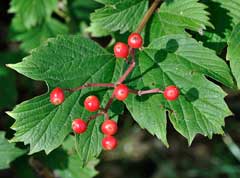
Guelder Rose, Cramp Bark, European cranberrybush, American cranberrybush, Crampbark, European Highb
Latin Name: Viburnum opulus
USDA Hardiness: 3-8
Native Range: TEMPERATE ASIA: Russian Federation-Ciscaucasia (Ciscaucasia), Armenia, Azerbaijan, Georgia, Russian Federation (Dagestan), Russian Federation-Western Siberia (Western Siberia), Russian Federation-Eastern Siberia (Eastern Siberia (southeast)), Kazakhstan, Kyrgyzstan, Russian Federation (Kurile Islands, Primorye, Amur), China (Anhui Sheng, Heilongjiang Sheng, Henan Sheng, Hebei Sheng, Hubei Sheng, Gansu Sheng, Jiangxi Sheng, Jilin Sheng, Liaoning Sheng, Shanxi Sheng, Shandong Sheng, Shaanxi Sheng, Sichuan Sheng, Nei Mongol Zizhiqu, Xinjiang Uygur Zizhiqu), Korea, Japan (Hokkaidô, Honshu) NORTHERN AMERICA: Canada (Québec (south), Nova Scotia, Ontario (south), Prince Edward Island, New Brunswick, Newfoundland and Labrador, Alberta (south), Manitoba (south), British Columbia (south)), United States (Indiana (north), Maine, Massachusetts, Michigan, New Hampshire, New Jersey, New York, Ohio (north), Pennsylvania, Vermont, West Virginia, Connecticut, Iowa (north), Minnesota, Nebraska (Douglas Co.), North Dakota, South Dakota, Illinois (north), Wisconsin, Idaho (north), Washington, Wyoming (Crook Co.), Virginia (north)) EUROPE: Denmark, Finland, United Kingdom, Ireland, Norway, Sweden, Czechoslovakia, Austria, Belgium, Switzerland, Germany, Hungary, Netherlands, Poland, Russian Federation (European part), Belarus, Estonia, Lithuania, Latvia, Moldova, Ukraine (incl. Krym), Former Yugoslavia, Albania, Bulgaria, Italy, Romania, France
Edibility Rating: 3 / 5
Medicinal Rating: 3 / 5
Region:
Family:
Plant Type:
Medicinal Uses
Edible Uses
Edible Parts: Fruit | Edible Uses: Fruit - raw or cooked[2, 3, 5, 46]. The fruit is up to 8.5mm in diameter but with a large seed[200]. A sour taste, it is best cooked. The crushed fruit has an unpleasant smell[4]. Used as a cranberry substitute in making, jellies, preserves etc[183]. Some caution is advised, see notes on toxicity at top of the page.
Cultivation
Landscape Uses:Border, Massing, Screen, Specimen. An easily grown plant, it succeeds in most soils but is ill-adapted for poor soils and for dry situations[1]. It prefers a deep rich moist loamy soil in a sunny position[11]. Succeeds in semi-shade but does not grow or fruit so well in such a position[186]. Grows well in heavy clay soils and on chalk[184]. Does not do well on very acid soils. Best if given shade from the early morning sun in spring[200]. A very ornamental plant[1], it is hardy to about -30°c[184] and is often grown in the flower garden. There are many named varieties[184]. Guelder rose regenerates quickly if it is cut to the ground, it can also produce suckers and will often form thickets[186]. The plant is an alternative host for the broad bean aphid[11]. Special Features: Not North American native, Naturalizing, Attractive flowers or blooms. In garden design, as well as the above-ground architecture of a plant, root structure considerations help in choosing plants that work together for their optimal soil requirements including nutrients and water. The root pattern is fleshy. Thick or swollen - fibrous or tap root [2-1].
Known Hazards
Large quantities of the fruit can cause vomiting and diarrhoea[10, 65]. The fruit is of very low or zero toxicity, it only causes mild upsets when eaten unripe or in large quantities[65, 76].
Habitats
Hedges, scrub and woodland, usually on damp soils[3, 13, 17].
